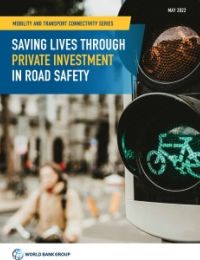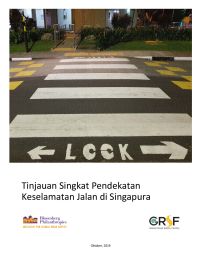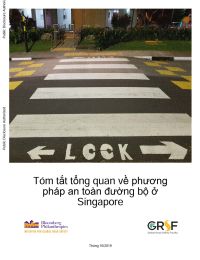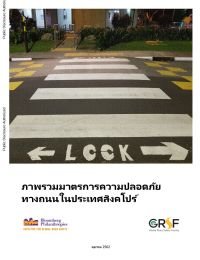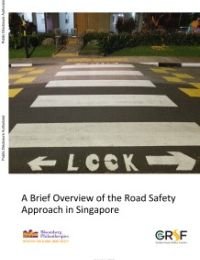Publications
1-5 of 5
-
-
Road Safety Management
Tinjauan Singkat Pendekatan Keselamatan Jalan di Singapura (Indonesian)
October 2019
-
Road Safety Management
Tóm tắt tổng quan về phương pháp an toàn đường bộ ở Singapore (Vietnamese)
October 2019
-
-

The World Bank estimates a significant funding gap in road safety of 260 billion to achieve SDG 3.6 and 11.2 in the next ten years, and recognizes that this gap cannot be closed through public funding alone and thus mobilization of private capital is required. The impacts of road traffic crashes reach far into the economy and can cost L/MICs as much as 6% of their GDP. The costs of a road traffic crash do not end at the roadside; they create ripple effects throughout the wider economy. Loss of income, property damage, insurance premiums, loss of taxes, and burdens on the health sector are just some of the far-reaching costs associated with road traffic crashes. Road traffic crashes can cost countries as much as 6 percent of their GDP and trap families in poverty as they lose income generating potential and focus on providing lifetime care.
This report examines the potential for private capital mobilization to close this gap. The report investigates the market failure to appropriately account for the cost of road crashes, which prevents private capital from flowing to road safety investments. The growth of socially responsible investing and the sustainable finance market offers a new opportunity to address this market failure. The report proposes different business models and financing instruments to channel private investment into road safety projects. These investment structures consist of subnational, public-private partnerships (PPPs) and corporate investments that can leverage the growing sustainable finance market, including social and sustainability-linked financings (SLFs).
The report also develops indicators that can be used to tie the cost of financing to the attainment of road safety targets, incentivizing borrowers to commit to road safety as part of SLFs. The report examines the enabling environment for structuring investable road safety projects in a sample of countries, looking at the barriers and opportunities, and proposing risks and mitigation strategies, like blended finance mechanisms and stable revenue sources, for long-term sustainability of road safety investments.
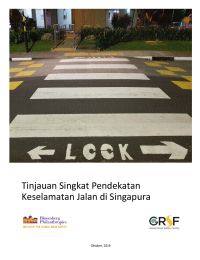
Laporan ini memperkenalkan cara kerja Pendekatan Sistem Aman, dengan fokus pada infrastruktur jalan dan praktik terbaik rekayasa keselamatan jalan dari salah satu negara dengan kinerja terbaik di Asia Tenggara dan Pasifik, Singapura.
Jalan-jalan di Singapura tidak hanya dianggap sebagai yang teraman di kawasan ini, tetapi juga termasuk yang teraman di dunia. Aturan dan regulasi manajemen keselamatan jalan yang diterapkan di negara ini telah menghasilkan langkah-langkah signifikan dalam mengelola dampak faktor tabrakan yang terkait dengan desain jalan raya, perilaku manusia, dan atribut kendaraan. Hasilnya, statistik keselamatan jalan menunjukkan bahwa jumlah kematian di jaringan jalan Singapura terus menurun selama dekade terakhir. Hal ini mendorong keinginan negara-negara tetangga untuk mengikuti contoh Singapura dan belajar dari pengalamannya.
Untuk mengurangi tabrakan yang disebabkan oleh kekurangan atau kerusakan kendaraan, salah satu langkah yang diambil di Singapura adalah memberlakukan kebijakan impor kendaraan yang ketat. Impor kendaraan diizinkan dari negara-negara yang telah mengadopsi dan mematuhi standar keselamatan kendaraan tinggi yang diakui. Kepatuhan terhadap keselamatan kendaraan secara khusus difokuskan pada 52 item yang ditetapkan oleh Otoritas Transportasi Darat (LTA). Selain standar impor kendaraan yang ketat, Singapura memberlakukan sistem kuota kendaraan yang ketat, yang mengatur jumlah kendaraan di jaringan jalan. Selain itu, kendaraan diharuskan menjalani inspeksi berkala. Mobil berusia antara 3 dan 10 tahun diharuskan menjalani inspeksi dua tahunan, dan mobil yang berusia lebih dari 10 tahun diharuskan menjalani inspeksi tahunan.
Selain itu, taksi diharuskan menjalani inspeksi setiap enam bulan. Pendidikan keselamatan jalan dan pendidikan pengemudi merupakan prinsip utama strategi keselamatan jalan Singapura. Pendidikan keselamatan jalan sebagian besar dilakukan oleh Polisi Lalu Lintas Singapura, tetapi organisasi nonpemerintah seperti Sekretariat Koordinasi Keamanan Nasional memberikan kontribusi yang signifikan terhadap pendidikan keselamatan jalan di Singapura.
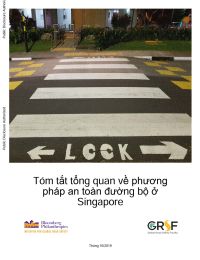
Báo cáo giới thiệu cách thức hoạt động của Phương pháp tiếp cận hệ thống an toàn, tập trung vào cơ sở hạ tầng đường bộ và các biện pháp thực hành tốt nhất về kỹ thuật an toàn đường bộ từ một trong những quốc gia có thành tích tốt nhất ở Đông Nam Á và Thái Bình Dương, Singapore.
Đường bộ Singapore không chỉ được coi là an toàn nhất trong khu vực mà còn được xếp hạng là một trong những quốc gia an toàn nhất trên toàn cầu. Các quy tắc và quy định về quản lý an toàn đường bộ được thực hiện tại quốc gia này đã mang lại những bước tiến đáng kể trong việc quản lý tác động của các yếu tố va chạm liên quan đến thiết kế đường bộ, hành vi của con người và các thuộc tính của phương tiện. Do đó, số liệu thống kê về an toàn đường bộ cho thấy số ca tử vong trên mạng lưới đường bộ Singapore đã giảm đều đặn trong thập kỷ qua. Điều này dẫn đến mong muốn của các quốc gia láng giềng là noi gương Singapore và học hỏi kinh nghiệm của nước này.
Để giảm thiểu các vụ va chạm do xe không đủ tiêu chuẩn hoặc lỗi, một trong những biện pháp được thực hiện tại Singapore là thực thi chính sách nhập khẩu xe nghiêm ngặt. Xe được phép nhập khẩu từ các quốc gia đã áp dụng và tuân thủ các tiêu chuẩn an toàn xe cao được công nhận. Việc tuân thủ an toàn xe đặc biệt tập trung vào 52 mục do Cơ quan Giao thông Đường bộ (LTA) chỉ định. Ngoài các tiêu chuẩn nhập khẩu xe nghiêm ngặt, Singapore còn thực thi hệ thống hạn ngạch xe nghiêm ngặt, quy định số lượng xe trên mạng lưới đường bộ. Ngoài ra, xe phải được kiểm tra thường xuyên. Xe từ 3 đến 10 năm tuổi phải được kiểm tra hai năm một lần, và xe trên 10 năm tuổi phải được kiểm tra hàng năm.
Ngoài ra, xe taxi phải được kiểm tra sáu tháng một lần. Giáo dục an toàn giao thông và giáo dục lái xe là những nội dung cốt lõi trong chiến lược an toàn giao thông của Singapore. Giáo dục an toàn giao thông chủ yếu do Cảnh sát giao thông Singapore thực hiện, nhưng các tổ chức phi chính phủ như Ban thư ký điều phối an ninh quốc gia cũng đóng góp đáng kể vào giáo dục an toàn giao thông tại Singapore.
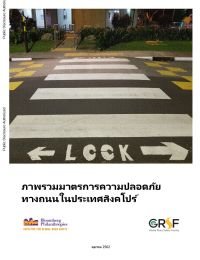
รายงานนี้แนะนำวิธีการทำงานของแนวทางระบบที่ปลอดภัย โดยเน้นที่โครงสร้างพื้นฐานทางถนนและแนวทางปฏิบัติที่ดีที่สุดด้านวิศวกรรมความปลอดภัยทางถนนจากหนึ่งในประเทศที่มีประสิทธิภาพสูงสุดในเอเชียตะวันออกเฉียงใต้และแปซิฟิก ซึ่งก็คือสิงคโปร์
ถนนในสิงคโปร์ไม่เพียงแต่ถือว่าปลอดภัยที่สุดในภูมิภาคเท่านั้น แต่ยังติดอันดับถนนที่ปลอดภัยที่สุดในโลกอีกด้วย กฎและข้อบังคับด้านการจัดการความปลอดภัยทางถนนที่นำมาใช้ในประเทศได้ส่งผลให้มีความก้าวหน้าอย่างมากในการจัดการผลกระทบของปัจจัยการชนที่เกี่ยวข้องกับการออกแบบถนน พฤติกรรมของมนุษย์ และคุณลักษณะของยานพาหนะ ส่งผลให้สถิติความปลอดภัยทางถนนแสดงให้เห็นว่าจำนวนผู้เสียชีวิตบนเครือข่ายถนนของสิงคโปร์ลดลงอย่างต่อเนื่องในช่วงทศวรรษที่ผ่านมา ส่งผลให้ประเทศเพื่อนบ้านมีความปรารถนาที่จะทำตามตัวอย่างของสิงคโปร์และเรียนรู้จากประสบการณ์ของประเทศ
เพื่อบรรเทาการชนที่เกิดจากความไม่เพียงพอหรือข้อบกพร่องของยานพาหนะ มาตรการอย่างหนึ่งที่ใช้ในสิงคโปร์คือการบังคับใช้นโยบายนำเข้ายานพาหนะที่เข้มงวด การนำเข้ายานพาหนะได้รับอนุญาตจากประเทศที่ได้นำมาตรฐานความปลอดภัยของยานพาหนะระดับสูงที่เป็นที่ยอมรับมาใช้และปฏิบัติตาม การปฏิบัติตามข้อกำหนดด้านความปลอดภัยของยานพาหนะนั้นเน้นเป็นพิเศษที่รายการ 52 รายการที่กำหนดโดย Land Transport Authority (LTA) นอกเหนือจากมาตรฐานการนำเข้ายานพาหนะที่เข้มงวดแล้ว สิงคโปร์ยังบังคับใช้ระบบโควตายานพาหนะที่เข้มงวด ซึ่งควบคุมจำนวนยานพาหนะในเครือข่ายถนน นอกจากนี้ ยานพาหนะยังต้องผ่านการตรวจสภาพบ่อยครั้ง รถยนต์ที่มีอายุระหว่าง 3 ถึง 10 ปีต้องผ่านการตรวจสภาพทุก ๆ สองปี และรถยนต์ที่มีอายุมากกว่า 10 ปีต้องผ่านการตรวจสภาพทุกปี
นอกจากนี้ รถแท็กซี่ต้องผ่านการตรวจสภาพทุก ๆ หกเดือน การศึกษาความปลอดภัยบนท้องถนนและการศึกษาของผู้ขับขี่ถือเป็นหลักการสำคัญของกลยุทธ์ความปลอดภัยบนท้องถนนของสิงคโปร์ การศึกษาความปลอดภัยบนท้องถนนส่วนใหญ่ดำเนินการโดยตำรวจจราจรของสิงคโปร์ แต่หน่วยงานที่ไม่ใช่ของรัฐ เช่น สำนักงานเลขานุการประสานงานด้านความมั่นคงแห่งชาติ มีส่วนสนับสนุนอย่างมากในการให้ความรู้ด้านความปลอดภัยบนท้องถนนในสิงคโปร์
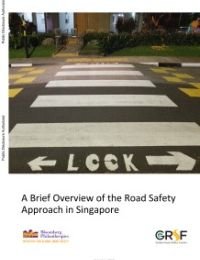
The report introduces how the Safe System Approach works, with a focus on road infrastructure and road safety engineering best practices from one of the best performing countries in Southeast Asia and the Pacific, Singapore.
Singapore roads are not only considered the safest in the region, they rank among the safest globally. Road safety management rules and regulations implemented in the country have resulted in significant strides in managing the effects of collision factors related to roadway design, human behavior, and vehicle attributes. As a result, road safety statistics have shown that fatalities on the Singapore road network have been steadily declining over the past decade. This is leading to a desire on the part of neighboring countries to follow Singapore's example and learn from its experience.
In order to mitigate collisions attributed to vehicle inadequacies or defects, one of the measures taken in Singapore was to enforce a strict vehicle import policy. Vehicle imports are permissible from countries that have adopted and comply with recognized high vehicle safety standards. Vehicle safety compliance is particularly focused on 52 items specified by the Land Transport Authority (LTA). In addition to strict vehicle import standards, Singapore enforces a strict vehicle quota system, which regulates the number of vehicles on the road network. Additionally, vehicles are required to undergo frequent inspections. Cars between 3 and 10 years old are required to have a biennial inspection, and cars older than 10 years are required to undergo annual inspections.
Furthermore, taxis are required to undergo inspections every six months. Road safety education and driver education are core tenants of Singapore's roads safety strategy. Road safety education is predominately undertaken by the Singapore Traffic Police, but nongovernmental organizations such as the National Security Coordination Secretariat contribute significantly to road safety education in Singapore.
Document also available in : Thai, Bahasa (Indonesian), Bahasa (Indonesian), Vietnamese

